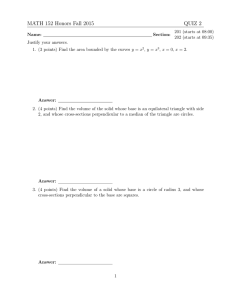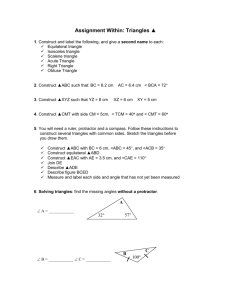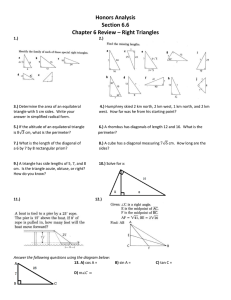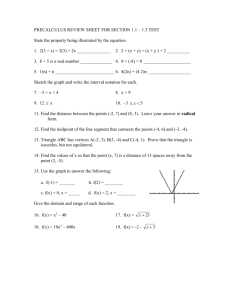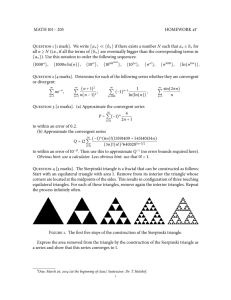Beitr¨ age zur Algebra und Geometrie Contributions to Algebra and Geometry
advertisement
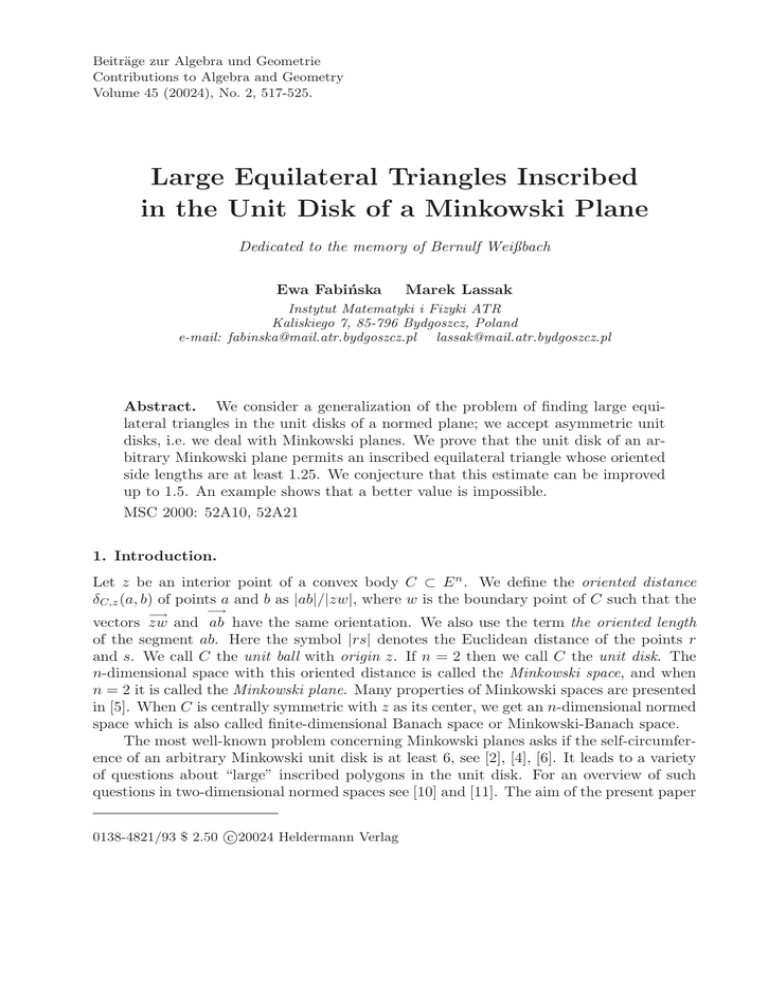
Beiträge zur Algebra und Geometrie
Contributions to Algebra and Geometry
Volume 45 (20024), No. 2, 517-525.
Large Equilateral Triangles Inscribed
in the Unit Disk of a Minkowski Plane
Dedicated to the memory of Bernulf Weißbach
Ewa Fabińska
Marek Lassak
Instytut Matematyki i Fizyki ATR
Kaliskiego 7, 85-796 Bydgoszcz, Poland
e-mail: fabinska@mail.atr.bydgoszcz.pl lassak@mail.atr.bydgoszcz.pl
Abstract. We consider a generalization of the problem of finding large equilateral triangles in the unit disks of a normed plane; we accept asymmetric unit
disks, i.e. we deal with Minkowski planes. We prove that the unit disk of an arbitrary Minkowski plane permits an inscribed equilateral triangle whose oriented
side lengths are at least 1.25. We conjecture that this estimate can be improved
up to 1.5. An example shows that a better value is impossible.
MSC 2000: 52A10, 52A21
1. Introduction.
Let z be an interior point of a convex body C ⊂ E n . We define the oriented distance
δC,z (a, b) of points a and b as |ab|/|zw|, where w is the boundary point of C such that the
−→
−→
vectors zw and ab have the same orientation. We also use the term the oriented length
of the segment ab. Here the symbol |rs| denotes the Euclidean distance of the points r
and s. We call C the unit ball with origin z. If n = 2 then we call C the unit disk. The
n-dimensional space with this oriented distance is called the Minkowski space, and when
n = 2 it is called the Minkowski plane. Many properties of Minkowski spaces are presented
in [5]. When C is centrally symmetric with z as its center, we get an n-dimensional normed
space which is also called finite-dimensional Banach space or Minkowski-Banach space.
The most well-known problem concerning Minkowski planes asks if the self-circumference of an arbitrary Minkowski unit disk is at least 6, see [2], [4], [6]. It leads to a variety
of questions about “large” inscribed polygons in the unit disk. For an overview of such
questions in two-dimensional normed spaces see [10] and [11]. The aim of the present paper
c 20024 Heldermann Verlag
0138-4821/93 $ 2.50 518
E. Fabińska, M. Lassak: Large Equilateral Triangles. . .
is to consider a particular question of this nature: how large an equilateral triangle can be
inscribed in an arbitrary Minkowski unit disk?
2. Equilateral triangles
Assume that we go in the boundary of a triangle according to the positive (respectively:
negative) orientation and that the oriented lengths of the sides are equal. We call such
a triangle an equilateral triangle in the positive (respectively: negative) orientation. Pay
attention that an equilateral triangle according to an orientation usually is not equilateral
after changing its orientation into the opposite. An equilateral triangle in the positive
orientation is also called an equilateral triangle for simplicity.
We shall describe a procedure for finding all equilateral triangles v1 v2 v3 of oriented
edge length 1. Assume that the first vertex, v1 , is given. Draw the unit disk C1 with the
−→
origin v1 (i.e. the translate of the unit disk C by the vector zv1 ).
C2
C2
C1 1
v3
v2
v1
v2
C1 1
v3
v1
C1
C1
Figure 1
Figure 2
Clearly, all the possible positions of v2 are on the boundary of C1 , see Figure 1 and Figure 2.
In order to find all the required positions of v3 , we draw the unit disk C2 whose origin is
v2 and the homothetic image C1−1 of C1 of ratio −1 with homothety center at v1 . Then,
v1 v2 v3 is equilateral if and only if v3 ∈ bd(C2 ) ∩ bd(C1−1 ). Beside an equilateral triangle
v1 v2 v3 , this way we also obtain an equilateral triangle v1 v2 v3− of negative orientation (see
Figure 1). It may also happen that for a given v1 , v2 there is no equilateral triangle whose
side is v1 v2 (see Figure 2).
Example. Let s1 , s2 , s3 , s4 be the four vertices of a square in C and let the origin z be a
point on the segment s1 s3 such that 2|zs1 | = |zs3 |.
E. Fabińska, M. Lassak: Large Equilateral Triangles. . .
C2
C1
v3
{
C1
519
v3
{
v1
v2
v1
v2
C1
1
C2
{
C1
1
v3
Figure 3
Figure 4
In Figures 3 and 4 we can see how to find v3 for given points v1 and v2 such that v1 v2 v3 is a
positively (or negatively) oriented equilateral triangle. Then v3 must be on the boundaries
of both C2 and C1−1 , i.e. on the segments which are marked by two kinds of broken lines
simultaneously. Notice that if in Figure 3 we take v2 at the right upper corner of C1 , then
we get only one possible position of v3 and that v1 v2 v3 degenerates to a segment: we have
v3 ∈ v1 v2 . On the other hand, if v2 is at the lower right corner (see Figure 4), v3 can be
taken at every point of bd(C2 ).
−→
We call a direction admissible if for the boundary points y1 and y2 of C such that y1 y2 is
of this direction and such that z ∈ y1 y2 , we have |y1 z|/|zy2 | ≥ 12 .
Claim 1. For any two given points v1 and v2 there exists a point v3 such that v1 v2 v3 is
−→
an equilateral triangle if and only if v1 v2 is an admissible direction.
Proof. Without loss of generality we may assume that δC,z (v1 , v2 ) = 1. Thus v2 ∈ bd(C1 ).
Here and below we stay with the notation introduced when describing the procedure of
finding equilateral triangles. Moreover, denote by v the Euclidean midpoint of the segment
v1 v2 .
−→
Assume that the direction v1 v2 is admissible. Then v ∈ C2 and v ∈ C1−1 . This and
the convexity of C1 and C2 implies bd(C2 ) ∩ bd(C1−1 ) 6= ∅. This guarantees the existence
of v3 such that v1 v2 v3 is equilateral.
−→
Assume that v1 v2 is not admissible. Then δC,z (v2 , v1 ) > 2. Since δC,z (a, b) satisfies the triangle inequality, as established by Minkowski [9], there is no v3 such that
δC,z (v2 , v3 ) = 1 and δC,z (v3 , v1 ) = 1 simultaneously. Thus for every v3 the triangle v1 v2 v3
is not equilateral.
From this proof we can also see that if C is strictly convex, then v3 is unique. Of course,
if C is not strictly convex it may happen that v3 is not unique like in Example.
Assume that a planar convex body C is given. Claim 1 leads to the question how
to determine the set of those positions of the origin z in the interior of C such that in
the obtained Minkowski plane for every v1 and v2 we can construct an equilateral triangle
520
E. Fabińska, M. Lassak: Large Equilateral Triangles. . .
v1 v2 v3 for every v1 and v2 . Claim 2 provides the answer; its proof, which is similar to that
of Claim 1, is left to the reader.
Claim 2. Denote by CH the set of those points s such that the image of C under the
homothety with center s and ratio − 12 is contained in C. There exists an equilateral
triangle v1 v2 v3 for every given v1 and v2 if and only if z ∈ CH .
3. Equilateral triangles inscribed in the unit disk
Papers [1], [3], [7], and [8] consider large equilateral polygons, and particular triangles,
inscribed in the unit disk of a two-dimensional normed space. Currently the best estimate
is given in [8], where it is shown that every such
√ unit disk permits an inscribed equilateral
triangle whose side length is at least 1 + 13 3 ≈ 1.577. A conjecture from [3] and [7] is
that √
in every such unit disk we can inscribe an equilateral triangle of sides length at least
1
1 + 2 2 ≈ 1.707. This value cannot be improved when the unit disk is the regular octagon
(see [3] and [7]). We intend to estimate how large equilateral triangle can be inscribed in
an arbitrary Minkowski unit disk C.
Conjecture. The unit disk of every Minkowski plane permits an inscribed equilateral triangle with oriented side length at least 1.5.
For the Minkowski plane whose unit disk is considered in the Example the value 1.5 cannot
be enlarged. This follows from the shape of the equilateral triangles v1 v2 v3 established in
−→
−→
−→
−→
the Example. Just observe that in the Example we always have v1 v2 = zw or v2 v3 = zw or
−→
−→
v3 v1 = zw for a point w ∈ s2 s3 ∪ s3 s4 . Hence if a positive homothetic image of v1 v2 v3 is
inscribed in the unit disk (square) C, then the ratio of this homothety is at most 1.5. This
implies that every equilateral triangle inscribed in the unit disk C has sides of oriented
length at most 1.5.
The question how large equilateral triangles can be inscribed in the unit disk of a
Minkowski plane does not seem to be easy. Some of the reasons are that only equilateral
triangles with sides of admissible directions exist, that their homothetic copies cannot
always be inscribed in the unit disk, and that for a given boundary point of C sometimes
in C we cannot inscribe an equilateral triangle with a vertex at this point (for instance,
the last two situations may happen in the space considered in the Example).
When we say that a point q is on the opposite side of a line L ⊂ E 2 than a point
p 6∈ L, we mean that the segment pq has non-empty intersection with L. We say that q is
strictly on the opposite side of L if, additionally, q 6∈ L.
Theorem. In every unit disk C one can inscribe an equilateral triangle of oriented side
length at least 1.25.
Proof. According to the earlier introduced notation, the symbol z denotes the origin.
Since z ∈ int (C), by continuity arguments we see that there are points b, e ∈ bd (C) such
−→
−→
that z is the midpoint of be (that is bz = ze ). Denote by g the midpoint of bz, and
by h the midpoint of ze. Again, continuity arguments guarantee that there are points
a, c, d, f ∈ bd (C) such that g is the midpoint of ac and that h is the midpoint of df .
E. Fabińska, M. Lassak: Large Equilateral Triangles. . .
521
Assume that the triangle abz has positive orientation (in this order), and that points a
and f are in one half-plane bounded by the straight line through b and z.
Observe that the choice of the points g, a, b and c implies that abcz is a parallelogram
−→
−→
with center g. This and bz = ze imply that the triangle abz is equilateral. Analogously,
def z is a parallelogram with center h and the triangle dez is equilateral. Both triangles
have sides of unit oriented length. Our intention is to show that a homothetic image of
ratio at least 1.25 of at least one of those triangles is inscribed in C.
We make the assumption that
<
) bza
≤
<
) ezd,
(1)
and we intend to show that a homothetic image of the triangle abz of a ratio at least
1.25 is inscribed in C. (If <) ezd ≤ <) bza, similar argument leads to the conclusion that a
homothetic image of the triangle dez of ratio at least 1.25 is inscribed in C.)
Assume that <) bza = 90◦ and that |ab| = 2. This is possible because we can apply a
convenient affine transformation. It matters here the obvious property that the oriented
length does not change under affine transformations. Some of the arguments of this proof
are simpler when we consider the Cartesian coordinate system Oxy in which z = (0, 0),
a = (−1, −1) and b = (1, −1). As a consequence, c = (2, 0), e = (−1, 1), g = ( 21 , − 12 )
and h = (− 12 , 12 ). By horizontal lines we mean lines parallel to the Ox-axis. By the level
of such a line we mean the y-coordinate of points of this line. We say that a point p2 is
above the level (respectively: below the level) of a point p1 provided the y-coordinate of p2
is greater (respectively: smaller) than the y-coordinate of p1 .
z'
z'
d
e
e
d
f
z
a'
c = b'
a'
f
a
b
Figure 5
z
c = b'
t
a
b
Figure 6
Consider the positive homothetic copy a0 b0 z 0 of the triangle abz such that b0 = c and that
a0 ∈ bd (C). Since abcz is a parallelogram, z ∈ a0 b0 .
Since b0 = c is on the opposite side of the straight line containing bz than f , from the
definition of the triangle a0 b0 z 0 we see that
z 0 is on the opposite side of the straight line containing bz than f.
Below in Cases 1 and 2 we show that z 0 6∈ int (C).
Case 1, when the segments ac and f d are disjoint.
(2)
522
E. Fabińska, M. Lassak: Large Equilateral Triangles. . .
Subcase 1.1, when f is not over the level of z.
In this subcase the segment a0 z intersects the segment ef (see Figure 5). From (1) and
since the points b, z, e are collinear, we conclude that the straight line through a and z
intersects the segment de. Those facts and the fact that def z is a parallelogram imply
that z 0 is on the opposite side of the line containing ef than z. Remember that (2) holds
true. Hence e belongs to the triangle f zz 0 . If we suppose that z 0 ∈ int (C), then by the
convexity of C all the points of the triangle f zz 0 beside f are in int (C). Since in Subcase
1.1 we have e 6= f , we see that e ∈ int (C). This contradicts e ∈ bd (C). Thus z 0 6∈ int (C).
Subcase 1.2, when f is over the level of z.
In this subcase the segments a0 z and af intersect at a point t.
z'
z'
f
e
e
f
z
d
a'
k
a
b
Figure 7
c = b'
z
c = b'
a'
d
a
b
Figure 8
Subcase 1.2.1, when f is on the opposite side of the line through a parallel to bz than z.
Since a0 z and af intersect, a0 is on the opposite side of the straight line containing et
than z (see Figure 6). This and |tz| ≥ 2 imply that z 0 is on the opposite side of the line
containing et than z. From this fact, statement (2), and the convexity of C we conclude
that z 0 6∈ int (C) (we provide an argument similar to Subcase 1.1).
Subcase 1.2.2, when f is not on the opposite side of the line through a parallel to bz than z.
Since d is symmetric to f with respect to h, we see that d and z are on one side of the
straight line through c parallel to bz (see Figure 7). This and b0 = c imply that z 0 is on
the opposite side than z of the line through d parallel to bz. Moreover, since a0 b0 z 0 is a
homothetic enlarged copy of abz and since the sum of levels of a and e is 0, we see that z 0
is over the level of e.
As a consequence of this and of the earlier statement that z 0 is on the opposite side
than z of the line through d parallel to bz, we conclude that z 0 is also on the opposite side
of the straight line containing the segment de. Denote by k the point of intersection of cz
with the straight line through d parallel to bz. From the convexity of C we obtain that
z 0 6∈ int (C) (we provide an argument like in Subcase 1.1; this time instead of points f , e,
and z we take points e, d, and k, respectively).
Case 2, when segments df and ac intersect.
Remember that (2) holds true. Of course, z 0 is over the level of e. From those facts and
from the fact that in Case 2 point f is not below the level of e we conclude that z 0 is on the
E. Fabińska, M. Lassak: Large Equilateral Triangles. . .
523
opposite side of the line containing ef than z (see Figure 8). This, (2) and the convexity
of C imply that z 0 6∈ int (C) (we use an argument like in Subcase 1.1).
As promised, we have established that z 0 6∈ int (C).
Below by H we denote the hexagon abcdef (respectively, abdcef ) when the assumption
of Case 1 (respectively, of Case 2) is fulfilled.
We intersect C by all horizontal lines which are between the lines containing segments ab and a0 b0 . Every such line (possibly besides the line containing ab) intersects the
boundary of C in two points a00 and b00 . Here the notation is chosen in order to have
−→
−→
ab = a00 b00 . The intersection of C and the line containing ab can be a boundary segment
a+ b+ of C. Then in this level we take all segments a00 b00 , where a00 = λa+ + (1 − λ)a and
b00 = λb+ + (1 − λ)b for 0 ≤ λ ≤ 1.
For every segment a00 b00 defined above denote by z 00 the point such that a00 b00 z 00 is
a positive homothetic image of abz. When a00 b00 = ab, we have z 00 = z ∈ int (C), and
when a00 b00 = a0 b0 , we have z 00 = z 0 6∈ int (C) (we have established this in Cases 1 and 2).
Consequently, by continuity arguments, there is a position of the triangle a00 b00 z 00 , denoted
below by aC bC zC , which is inscribed in C.
In particular, in H we can inscribe a homothetic image aH bH zH of abz in H. From
(1) we see that aH ∈ af . Obviously, in Case 1 we have bH ∈ bc. We leave it for the reader
to show that in Case 2 we have bH ∈ bd (hint: since d is symmetric to f with respect to
h and since H is convex, d is on the opposite side of the line through z parallel to ce than
z).
Denote by rH and rC the homothety ratios of the homotheties which transform abz
into aH bH zH and into aC bC zC , respectively. We intend to show that rH ≤ rC .
Consider the translation τ such that τ (aH )τ (bH ) is a segment of the form a00 b00 considered earlier. Clearly, τ (aH ), τ (bH ) ∈ bd (C). Moreover, observe that τ (zH ) and zH are
on the same sides of the lines containing ez and az. We can see that τ (zH ) is in the quadrangle zuzH w (the order of these points agrees with the orientation) enclosed by four lines:
the lines containing ez and az, and the lines through zH parallel to af and to bc in Case 1
(respectively bd in Case 2). Of course, z, zH , w ∈ C. It is clear that in Case 2 also u ∈ C.
In Case 1, from the fact that def z is a parallelogram it follows that lines containing af
and de intersect at a point v such that e ∈ dv and f ∈ av. It implies that also in Case 1 we
have u ∈ C. Thus the quadrangle zuzH w is contained in C. As a consequence, τ (zH ) ∈ C.
We can see that τ (aH )τ (bH )τ (zH ) is contained in C. Hence the level of points aC , bC is
not below the level of points τ (aH ), τ (bH ). So |aC bC | ≥ |τ (aH )τ (bH )| = |aH bH |. As a
consequence, rH ≤ rC .
We can see that in order to show that the triangle aC bC zC is an image of the triangle
abz under a homothety with a ratio at least 1.25 it is sufficient to show that we can inscribe
a homothetic copy aH bH zH of the triangle abz of ratio 1.25 in the hexagon H.
Denote by d0 the point of intersection of the segment dz with the segment ec in Case
1 (respectively, with bc in Case 2). Moreover, denote by f0 the new specific position of f
which is a consequence of exchanging the position of d into d0 ; from the fact that def z
(and thus also d0 ef0 z) is a parallelogram it follows that f0 is in the segment ef . The
case when we deal with the pentagon abcef0 = abcd0 ef0 in Case 1 (respectively, with
abcef0 = abd0 cef0 in Case 2) is a special case of our general situation when we have the
524
E. Fabińska, M. Lassak: Large Equilateral Triangles. . .
hexagon abcdef (respectively, abdcef ). We see that the pentagon abcef0 is a subset of
the hexagon H. As a consequence, it is sufficient to show that a homothetic copy of the
triangle abz of a ratio at least 1.25 is inscribed in the pentagon abcef0 .
Again let us reduce the preceding situation in Case 1 to a more specific case. We
mean the case when <) bza = <) ezd0 . Since d0 ef0 z is a parallelogram, we see that the
resulting specific position f1 of f0 is in the segment f0 z. As a consequence, the pentagon
P = abcef1 is a subset of the pentagon abcef0 (see Figure 9).
f
f0
e
f0
f
f1
aP
a
e
zP
f1
d
d1
d0
c
d0
z
z
b
Figure 9
bP
c
d
a
b
Figure 10
Since ef1 is parallel to az and since f1 z is parallel to ec, we easily obtain that f1 = (− 32 , 12 ).
It is easy to show that also in Case 2 the pentagon P = abcef1 is a subset of the pentagon
abcef0 (see Figure 10). We conclude that it is sufficient to show that a homothetic copy
of the triangle abz of ratio 1.25 is inscribed in abcef1 .
The intersection point p = (− 21 , − 52 ) of the straight lines containing af1 and bc is
the center of the homothety which transforms the triangle abz into the required triangle
aP bP zP with zP ∈ ec. A simple calculation shows that zP = ( 81 , 58 ) and, as a consequence,
that the ratio of this homothety is 1.25.
The example of the pentagon P considered at the end of the proof of the Theorem shows
that by the approach of this proof we cannot improve the obtained estimate 1.25.
It is clear that the √
unit disk of the Euclidean plane permits an inscribed equilateral
triangle of edge lengths 3. Claim 3 shows that if we move the origin z from the center of
the disk, we still can inscribe an equilateral triangle of sides of at least the same oriented
length of sides.
Claim 3. Consider the Minkowski plane whose unit disk is the usual circular disk with
z at any interior point of the disk. The √unit disk permits an inscribed equilateral triangle
whose oriented side lengths are at least 3.
Proof. Consider the disk x2 + y 2 ≤ 1 with z = (0, λ), where λ ∈ [0, 1). Put o = (0, 0).
Construct an equilateral triangle according to the procedure given in the proof of the
Theorem using the same
√ notation.
√
Of course, b = ( 1 − λ2 , λ) and thus g = ( 12 1 − λ2 , λ). The equation of the straight
√
2
3λ2 +1
line through g perpendicular to the segment og is y = − 1−λ
intersection
2λ x +
4λ . The
q
√
2
of this line with the circle x2 + y 2 = 1 gives point a = 21 1 − λ2 + λ 3−3λ
3λ2 +1 , λ −
E. Fabińska, M. Lassak: Large Equilateral Triangles. . .
525
q
− λ2 ) 3λ23+1 . Having the coordinates of the vertices of the triangle abz we can find
the perpendicular bisectors of the segments az and bz, and their point of intersection which
is the center r0 of the circle circumscribed about abz. We
time consuming
√omit an easy but
√
1
1
2
calculation which leads to the conclusion that r0 = 2 1 − λ , λ − 6 9λ2 + 3 . Thus
√
we easily get |r0 z| = 13 3. This implies that a positive homothetic copy of abz of ratio
√
3 is inscribed in the circle x2 + y 2√= 1. Obviously, this homothetic copy is an equilateral
triangle of sides of oriented length 3.
1
2 (1
References
[1] Bezdek, A.; Fodor, F.; Talata, I.: Applications of inscribed affine regular polygons
in convex disks. Proceedings of International Scientific Conference on Mathematics
(Žilina) 1998, 19–27.
Zbl
0952.52002
−−−−
−−−−−−−−
[2] Chakerian, G. D.; Talley, W. K.: Some properties of the self-circumference of convex
sets. Arch. Math. 20 (1969), 431–443.
Zbl
0185.25702
−−−−
−−−−−−−−
[3] Doyle, P. G.; Lagarias, J. C.; Randall, D.: Self-packing of centrally symmetric convex
bodies in R2 . Discrete Comput. Geom. 8 (1992), 171–189.
Zbl
0756.52016
−−−−
−−−−−−−−
[4] Gola̧b, S.: Some metric problems of the geometry of Minkowski. Trav. Acad. Mines
Cracovie 6 (1932), 1–79. (Polish)
Zbl
0006.32002
−−−−
−−−−−−−−
[5] Gola̧b, S.; Härlen, H.: Minkowskische Geometrie. Monatsh. für Math. Physik 38
(1931), 387–398.
Zbl
0002.35301
−−−−
−−−−−−−− and JFM
−−−−−57.0968.09
−−−−−−−−
[6] Grünbaum, B.: Self-circumference of convex sets. Colloq. Math. 13 (1964), 55–57.
Zbl
0123.15701
−−−−
−−−−−−−−
[7] Lassak, M.: On five points in a plane convex body pairwise in at least unit relative distances. Colloq. Math. Soc. János Bolyai 63, Szeged 1991, 245–247. Zbl
0822.52001
−−−−
−−−−−−−−
[8] Lassak, M.: Affine-regular hexagons of extreme areas inscribed in a centrally symmetric convex body. Adv. Geom. 3 (2003), 45–51.
Zbl
1026.52004
−−−−
−−−−−−−−
[9] H. Minkowski, Diophantische Approximationen, Teubner, Leipzig 1907.
JFM
−−−−−38.0220.15
−−−−−−−−
Reprinted: Physika, Würzburg, 1961.
[10] Martini, H.; Swanepoel, K. J.; Weiss, G.: The geometry of Minkowski spaces – a
survey. Part 1. Expo. Math. 19 (2001), 97–142.
Zbl
0984.52004
−−−−
−−−−−−−−
[11] Thompson, A. C.: Minkowski Geometry. Cambridge University Press, Cambridge
1996.
Zbl
0868.52001
−−−−
−−−−−−−−
Received August 1, 2003



